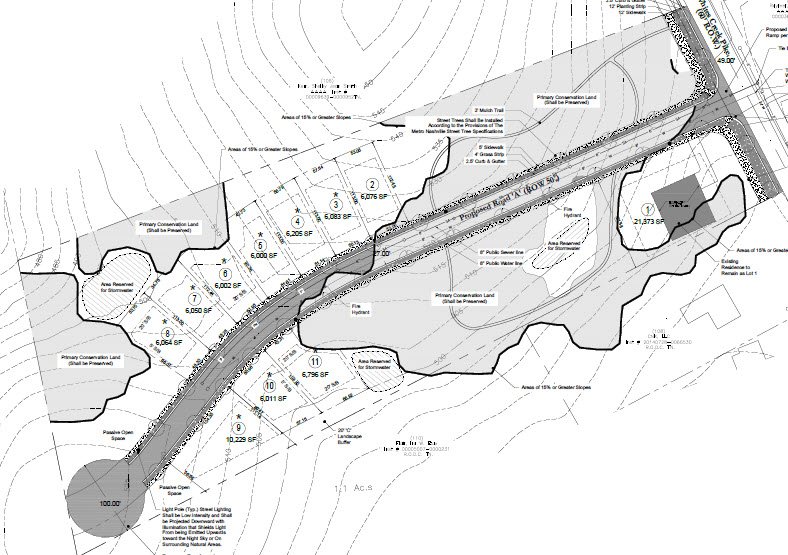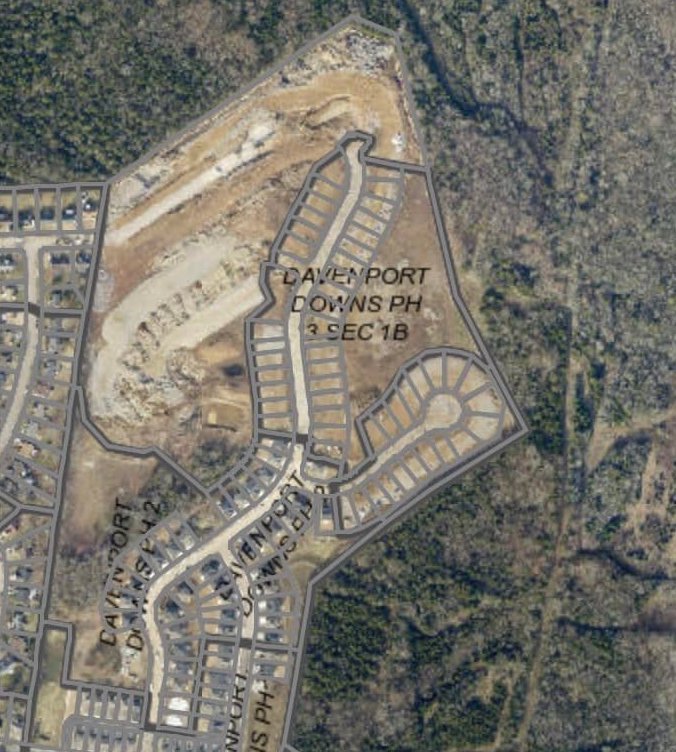Council approves important zoning change
New environmental protections for residential subdivisions
A change in Nashville’s residential zoning codes approved by the Metro Council will help to secure greater protections for environmentally sensitive natural areas throughout Davidson County.
Council Member Angie Henderson was lead sponsor for two bills that will revamp zoning regulations for “cluster lots” under a newly created Conservation Development umbrella. The Nashville Tree Conservation Corps strongly supported the legislation and provided case study analysis, technical comments and stakeholder input during the months-long process of crafting and amending the bills.
BL2022-1121 and its companion bill, BL2022-1122, passed the Council on third and final reading May 17.
A typical cluster lot subdivision design under previous Metro regulations.
"NTCC worked closely with the Planning Department and CM Angie Henderson for over a year while this ordinance was being drafted,” said Will Worrall, NTCC vice chair. “As a direct result of our feedback, mature trees are now included in the list of natural features protected under the code. Lots of other improvements were made too. This is a great step forward for our tree canopy, our wildlife, our neighborhoods, our people, and for Nashville's special natural areas."
“As a direct result of [NTCC] feedback, mature trees are now included in the list of natural features protected under the code.”
According to an analysis by Planning Commission staff, “The Conservation Development tool would require the preservation of some natural areas, including steep slopes and hillsides, streams and floodplains, problem soils, archaeological resources, and native forests or vegetation, under certain situations by allowing for flexibility in lot size in a residential subdivision.”
This new Conservation Development approach to zoning evolved after the Planning Commission asked its staff to review cluster lot regulations in early 2021. The Cluster Lot Option was first incorporated in Nashville’s zoning code in the late 1990s as a means to allow developers to build on lots smaller than the minimum zoned lot size for an area, in exchange for the creation of common open space in each development. For example, on a site with RS10 zoning, cluster lots could be reduced from 10,000 square feet to 5,000 square feet. Previous codes also required that 15 percent of a cluster lot subdivision be set aside as open space. Many Nashvillians have noted a number of concerns with current cluster lot regulations, including concerns such as incompatible developments, lack of functional open space, and little to no preservation of natural areas.
The two bills approved by the Council will amend cluster lot zoning to put the focus squarely on preservation of natural areas in new subdivisions — “both for the ecological services they provide and their contribution to Nashville’s unique character.”
An example of how subdivision design can be improved under new legislation to protect natural areas.
The revised rules will apply to any new subdivisions in which at least 10 percent of the site contains a combination of designated natural areas (floodplains, streams, slopes greater than 20 percent, problem soils, habitats for rare or endangered species, historic sites, and heritage and specimen trees). The new rules would require up to 20% of designated natural areas to be preserved, and would encourage an even higher rate of land preservation. This would mean that if the development site is forested, at least 20% of the forest would now be preserved.
A formula outlined in the bills would allow lot sizes in each affected subdivision to be reduced by the same percentage as that set aside for protecting natural areas. For example, if 10 percent of a site is protected natural area, lot sizes can be reduced by 10 percent. If 35 percent of a site is protected natural area, lots sizes can be reduced by 35 percent. The minimum lot size cannot go below 3,750 square feet for single family home developments. The revised zoning rules are intended to help preserve natural areas, while not reducing the number of allowable homes.
Trees as important natural features
For the first time, the bills recognize Nashville's trees as important natural features, rather than simply as landscaping requirements. The legislation also consolidates tree preservation and replacement codes into a single section, and updates references to tree preservation throughout Metro code.
An aerial view shows indiscriminate clearcutting at a recent cluster development. The new legislation recognizes mature trees as important natural features that should be protected at development sites.
The Planning Commission report on the legislation notes that, “This Conservation Development amendment is not intended to address all the problems or issues that have been identified with the creation of new residential subdivisions. These standards are intended to guide development on parcels with environmentally sensitive areas by encouraging these decisions to be based on the characteristics of the land in a site-specific way."
The legislation, which will become effective September 14 , also sets a 20 percent preservation requirement threshold. If less than 20 percent of a site consists of designated natural areas, all those areas must be undisturbed and in open space. If more than 20 percent of a site is natural areas, a minimum of 20 percent must be preserved. This is a significant change that will help to preserve more of Nashville’s dwindling green spaces.



